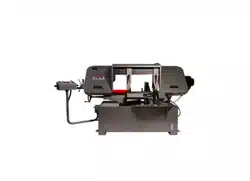Loading ...
Loading ...
Loading ...

10
8.5 Blade guide bearing adjustment
Proper adjustment of blade guide bearings is critical
to efficient operation of the saw. The blade guide
bearings have been adjusted by the manufacturer.
They should rarely require adjustment except after
a blade change. Failure to maintain proper blade
adjustment may cause serious blade damage or
inaccurate cuts.
It is always better to try a new blade when cutting
performance is poor. If performance remains poor
after changing the blade, make the necessary
adjustments.
If a new blade does not correct the problem, check
the blade guides for proper spacing. For most
efficient operation and maximum accuracy, provide
only very slight clearance between blade and guide
bearings. The bearings will still turn freely with this
clearance. If the clearance is incorrect, the blade
may track off the drive wheel.
Check blade to make sure
welded section is same thickness as rest of
blade. If blade is thicker at weld, the guide
bearings may be damaged.
If required, adjust guide bearings as follows:
1. Disconnect machine from power source.
2. Two bearing guide assemblies are used in each
set of blade guides. The inner bearing guide
assembly is fixed; the outer bearing guide
assembly is mounted to an eccentric shaft and
is adjustable.
3. On the inner bearing guide, hold the bushing
with the 19mm wrench and loosen the center
locking screw with a hex wrench (see Figure 8-
4).
4. Position the bearing by turning the bushing. Set
the bearing in contact with blade then back it off
very slightly so that it will still turn by hand.
5. Tighten center locking screw while holding the
eccentric bushing in position with the 19mm
wrench.
6. The support bearing (see G, Figure 8-2)
prevents deflection of blade under pressure
from the workpiece. Set support bearing so that
it nearly contacts back edge of blade but can
still be turned by hand when blade is not
running.
7. Use knurled knob to tighten carbide guides
against blade. Do not overtighten.
Figure 8-4
8.6 Test cutting to verify adjustment
Test cuts can be used to determine whether or not
you have adjusted the blade accurately. Use 2-inch
round bar stock to perform these test cuts, as
follows:
1. With bar stock securely clamped in the vise,
make a cut through the bar stock (see Figure 8-
5).
2. Mark the top of the bar stock.
3. Move the bar stock about 1/4-inch past the
blade so that you can begin a second cut.
4. Rotate the bar stock 180 degrees so the mark
you made is now at the bottom of the cut.
5. Make a cut through the bar stock.
6. Use a micrometer to measure the thickness
variation of the disk you have cut from the bar
stock. Measure at top and bottom of disk.
The saw blade can be considered correctly adjusted
when the variation measure is no more than 0.012
inch across the face of the disk.
If you do not have a piece of 2-inch bar stock
available for a test cut, use a larger diameter test
piece rather than a smaller one. The maximum
thickness variation on any test piece should be no
more than 0.003 inch, per side, per inch of stock
diameter.
Loading ...
Loading ...
Loading ...
